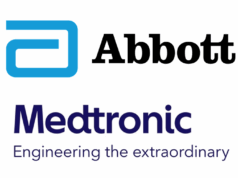 Abbott announced yesterday that it has received CE-mark approval in Europe for the Volt pulsed field ablation (PFA) system to treat patients with atrial fibrillation (AF). Following what the company describes as an “earlier-than-expected” CE mark, Abbott has begun commercial PFA cases in the European Union (EU) with physicians who have already gained experience with the Volt PFA system within Abbott’s PFA clinical studies. The company will further expand usage of Volt in EU markets throughout the second half of this year, as per a press release.
Abbott announced yesterday that it has received CE-mark approval in Europe for the Volt pulsed field ablation (PFA) system to treat patients with atrial fibrillation (AF). Following what the company describes as an “earlier-than-expected” CE mark, Abbott has begun commercial PFA cases in the European Union (EU) with physicians who have already gained experience with the Volt PFA system within Abbott’s PFA clinical studies. The company will further expand usage of Volt in EU markets throughout the second half of this year, as per a press release.
Abbott claims that the Volt PFA system builds upon the company’s leading electrophysiology (EP) portfolio by providing a single-catheter PFA approach, improving workflows by allowing for mapping, pacing and ablating to be performed safely and effectively with a single catheter in AF treatments.
CE-mark approval for the Volt PFA system was granted based on “strong results” from Abbott’s Volt CE mark study, a global clinical trial conducted at centres in Europe and Australia, the company claims. The trial showed that the Volt PFA system achieved pulmonary vein isolation (PVI) in 99.1% of veins during ablation procedures with “far fewer” energy applications compared to on-market competitive PFA systems.
Following approval, initial cases were completed by Helmut Pürerfellner at Ordensklinikum (Linz, Austria); Roland Tilz at the University Heart Center (Lübeck, Germany); Gian-Battista Chierchia at the University of Brussels (Brussels, Belgium); and Peter Loh at the University Medical Center Utrecht (Utrecht, The Netherlands).
“The launch of Abbott’s Volt PFA system marks a major milestone in the evolution of electrophysiology across Europe and signals we’re moving beyond early therapy approaches to new systems that incorporate key physician feedback and clinical insights to optimise PFA therapy,” said Pürerfellner. “PFA is significantly changing our approach to treating patients and it’s exciting to see the Volt PFA system build on the therapy’s potential and bring new benefits to clinical teams so we can improve the lives of more patients battling conditions like AF.”
According to Abbott, PFA works differently from traditional ablation approaches by delivering high-energy electrical pulses to targeted areas of cardiac tissue causing abnormal heart rhythms—and, as a result, PFA can reduce the risk of damaging adjacent tissue in patients with complex disease or anatomy. However, the company’s recent release continues, current on-market competitive PFA systems typically require several therapy applications with a catheter positioned in various locations due to a lack of visualisation or contact assessment. By integrating with Abbott’s EnSite X EP system, the Volt PFA system is designed to address such limitations and provide the following benefits:
- Simplified workflow—the single-catheter integrated approach of the Volt PFA system improves clinical workflow and provides real-time contact visualisation to help physicians position the catheter for therapy delivery
- Efficient energy delivery—the proprietary balloon-in-basket design of the Sensor-Enabled Volt PFA catheter allows for efficient energy transfer directly to the targeted tissue to stop the heart’s erratic signals, minimising the number of therapy applications needed
- Procedural flexibility—patients undergoing a minimally invasive ablation procedure with the Sensor-Enabled Volt PFA catheter can be placed under light sedation or general anaesthesia based on physician and hospital preference
In addition, the Volt PFA catheter’s integration with the EnSite X system allows clearer visualisation and navigation for accurate positioning of the Volt PFA catheter to treat tissue, Abbott states, adding that the ‘One System Solution’ provided by EnSite X can accommodate all EP procedures and compatible technologies.
“While PFA is a relatively new therapy option, we’ve incorporated lessons learned from first-generation devices and designed the Volt system to simplify PFA procedures while making them more efficient,” said Christopher Piorkowski, chief medical officer of Abbott’s EP business. “Clinical data have also shown that the Volt catheter’s cutting-edge design helps physicians achieve pulmonary vein isolation in fewer ablation attempts and less therapy applications for improved patient outcomes.”
Abbott’s Volt PFA system is currently under evaluation in the VOLT-AF investigational device exemption (IDE) study, which completed enrolment last year—four months ahead of the anticipated timeline. Nearly 400 patients are enrolled in the trial, and Abbott anticipates completing the 12-month follow-up for the study later this year.
In addition, the company claims to have made significant progress in clinical studies evaluating its focal PFA technology, which is designed to provide focused energy delivery for the creation of targeted lesions at specific points in the heart. Enrolment was recently completed ahead of schedule in Abbott’s FOCALFLEX CE trial assessing the performance of the Sensor-Enabled TactiFlex Duo ablation catheter, and enrolment is underway in the FlexPulse IDE trial evaluating TactiFlex Duo in the USA as well.
Abbott also recently received regulatory approval in the USA and Europe for a 13Fr sizing of the company’s Agilis NxT steerable introducer, Dual Reach, which makes the Agilis system compatible with larger catheters—including those used for PFA therapy.












